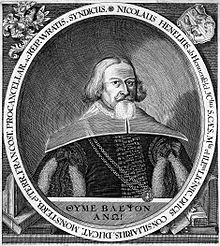Nicolaus Henel von Hennenfeld

(Archive of the University of Marburg )
Nicolaus Henel , from 1642 Nicolaus Henel von Hennenfeld (born January 11, 1582 in Neustadt , Upper Silesia , † July 23, 1656 in Breslau ) was a German senior syndic , biographer , chronicler and historian .
family
He was - according to his own report - the youngest of 11 children of Neustädter Magister and pastor Stephan Henel (1546–1602) and Anna Kühne († 1596).
Henel married in his first marriage on October 8, 1619 (probably) in Breslau Anna Partisch († January 8, 1641), the daughter of Martin Partisch, the imperial beer drinker in Breslau, and the Magdalene porter from Hell.
His second marriage was on July 14, 1643 (probably also) in Breslau Kunigunde Jessinsky von Groß-Jessen, the daughter of Esaias Jessinsky and Groß-Jessen and Magdalena von Hertwig. She was the stepdaughter of the Breslau Council President Stanislaus Aichhäuser von Leonhardwitz, who had adopted her as the niece of his wife after the death of their two children.
On May 30, 1642 Henel was in the Bohemian - erbländischen Erbadelsstand charged with names increase of his "Henel of Henn field."
Life
Henel attended the Neustadt Latin School from 1594 to 1596, and then went to the Elisabeth Gymnasium in Breslau for two years . From 1600 he studied law , medicine and philosophy at the University of Jena , then at the University of Basel , where he also received his doctorate. jur. utr. PhD .
After completing his studies, he went on an academic educational journey with friends, during which he enrolled in the law faculties of the respective universities and which took him through the Rhineland , the Netherlands , France ( Orléans University in 1610) and Italy , where he registered on November 6, 1610 at the University of Padua and on June 9, 1611 at the University of Siena .
In 1612 Henel returned to Silesia, was for a short time private tutor of the three sons of Nicolaus Rehdiger in Striesa in the Neumarkt district and from 1613 he worked as a lawyer in Breslau.
In 1618 he went into the service of the Duchy of Münsterberg as regional clerk and imperial councilor , was princely Liegnitz-Brieg-Wohlau councilor and resigned from office as Pro Chancellor in 1639 in order to take up a long-awaited job as a syndic in Breslau, which he did until his Death last held as senior counsel. In Breslau he lived on the Salzring, the later Blücherplatz.
In 1642 Henel was also appointed Imperial Councilor in the Weichbild Frankenstein .
During his years in Breslau he developed into a successful and wealthy private scholar and in 1651 acquired the Kurtwitz estate in the Nimptsch district , and later the two estates at Olbendorf and Grünheide in the Strehlen district .
On September 22nd, 1653 he was awarded the title of Count Palatinate . In this role he awarded a. a. the coat of arms letter to Elias Maior († 1706), vice principal and professor at the Elisabeth high school in Breslau, which Henel had once attended himself.
In addition to his biographical writings and Latin poetry, Henel's works include, above all, his historical works, which became very important in the history of the Silesian region.
Works (selection)
- Silesiographia , first edition 1613. - Supplemented reprint of Henels collected material in 10-fold volume, Prelate Fibinger (ed.): Silesiographia renovata necessariis scholiis, observationibus et indice aucta , 3 parts in 2 volumes, Verlag Christoph Bauch, Breslau and Leipzig 1704. - The Silesiographia is the first scientifically founded collective work about Silesia, is considered to be the literary conclusion of late humanism in Silesia.
- Silesia Togata (manuscript), the first Silesian scholarly story with over 600 biographies of Silesian humanists and nobles.
- Breslographia , 1613.
literature
- Oskar Pusch : The Breslauer Rats- und Stadtgeschölker in the period from 1241 to 1741 , Volume 2, Page 140, publications of the Research Center East Central Europe at the University of Dortmund, Series B No. 35, Dortmund 1987, ISBN 3-923293-20-8 , ISSN 0931-5306 .
- Wolfgang Kessler: Nikolaus Henel as a historiographer . In: Gerhard Kosellek (ed.): Upper Silesian poets and scholars from humanism to the baroque . Conference series of the Haus Oberschlesien Foundation, Volume 8, Bielefeld 2000.
- Gunhild Roth: Nikolaus Henel and his position in the Silesian historiography . In: Gerhard Kosellek (ed.): The Upper Silesian literary landscape in the 17th century . Conference series of the Haus Oberschlesien Foundation, Volume 11, Bielefeld 2001.
- Claudia Zonta: Silesians at Italian universities in the early modern period 1526–1740 . Dissertation to Dr. phil. at the Faculty of History, Social and Economic Sciences of the University of Stuttgart, Historical Institute of the University of Stuttgart, 2000.
- Colmar Grünhagen : Henel von Hennenfeld, Nicolaus . In: Allgemeine Deutsche Biographie (ADB). Volume 11, Duncker & Humblot, Leipzig 1880, p. 737.
Web links
- Literature list in the online catalog of the Berlin State Library
- Works by and about Nicolaus Henel von Hennenfeld in the German Digital Library
- Claudia Zonta (PhD thesis): "Silesians at Italian universities in the early modern period 1526–1740"
- Funeral sermons on Henel's death (University of Marburg)
- Nicolaus Henel von Hennenfeld: Silesiographia - Breslo-Graphia, Frankfurt am Main 1613. Online edition, ed. v. Detlef Haberland.
- Nicolaus Henel von Hennenfeld Silesiographia - Breslo-Graphia Frankfurt am Main 1613 with a detailed biography
| personal data | |
|---|---|
| SURNAME | Henel von Hennenfeld, Nicolaus |
| ALTERNATIVE NAMES | Henel, Nicolaus |
| BRIEF DESCRIPTION | German biographer, chronicler and historian |
| DATE OF BIRTH | January 11, 1582 |
| PLACE OF BIRTH | Neustadt , Upper Silesia |
| DATE OF DEATH | July 23, 1656 |
| Place of death | Wroclaw , Lower Silesia |

